Supermicro X9SCA-F Manual

X9SCi-LN4
X9SCi-LN4F
X9SCA
X9SCA-F
USER’S MANUAL
Revision 1.1b

The information in this User’s Manual has been carefully reviewed and is believed to be accurate. The vendor assumes no responsibility for any inaccuracies that may be contained in this document, makes no commitment to update or to keep current the information in this manual, or to notify any person or organization of the updates. Please Note: For the most up-to-date version of this manual, please see our web site at www.supermicro.com.
Super Micro Computer, Inc. ("Supermicro") reserves the right to make changes to the product described in this manual at any time and without notice. This product, including software and documentation, is the property of Supermicro and/or its licensors, and is supplied only under a license. Any use or reproduction of this product is not allowed, except as expressly permitted by the terms of said license.
IN NO EVENT WILL SUPER MICRO COMPUTER, INC. BE LIABLE FOR DIRECT, INDIRECT, SPECIAL, INCIDENTAL, SPECULATIVE OR CONSEQUENTIAL DAMAGES ARISING FROM THE USE OR INABILITY TO USE THIS PRODUCT OR DOCUMENTATION, EVEN IF ADVISED OF THE POSSIBILITY OF SUCH DAMAGES. IN PARTICULAR, SUPER MICRO COMPUTER, INC. SHALL NOT HAVE LIABILITY FOR ANY HARDWARE, SOFTWARE, OR DATA STORED OR USED WITH THE PRODUCT, INCLUDING THE COSTS OF REPAIRING, REPLACING, INTEGRATING, INSTALLING OR RECOVERING SUCH HARDWARE, SOFTWARE, OR DATA.
Any disputes arising between manufacturer and customer shall be governed by the laws of Santa Clara County in the State of California, USA. The State of California, County of Santa Clara shall be the exclusive venue for the resolution of any such disputes. Supermicro's total liability for all claims will not exceed the price paid for the hardware product.
FCC Statement: This equipment has been tested and found to comply with the limits for a Class B digital device pursuant to Part 15 of the FCC Rules. These limits are designed to provide reasonable protection against harmful interference in a residential installation. This equipment generates, uses, and can radiate radio frequency energy and, if not installed and used in accordance with the manufacturer’s instruction manual, may cause interference with radio communications. However, there is no guarantee that interference will not occur in a particular installation. If this equipment does cause harmful interference to radio or television reception, which can be determined by turning the equipment off and on, you are encouraged to try to correct the interference by one or more of the following measures:
•Reorient or relocate the receiving antenna.
•Increase the separation between the equipment and the receiver.
•Connect the equipment into an outlet on a circuit different from that to which the receiver is connected.
•Consult the dealer or an experienced radio/television technician for help.
California Best Management Practices Regulations for Perchlorate Materials: This Perchlorate warning applies only to products containing CR (Manganese Dioxide) Lithium coin cells. “Perchlorate Material-special handling may apply. See www.dtsc.ca.gov/hazardouswaste/perchlorate”.
WARNING: Handling of lead solder materials used in this product may expose you to lead, a chemical known to the State of California to cause birth defects and other reproductive harm.
Manual Revision 1.1b Release Date: May 4, 2016
Unless you request and receive written permission from Super Micro Computer, Inc., you may not copy any part of this document. Information in this document is subject to change without notice. Other products and companies referred to herein are trademarks or registered trademarks of their respective companies or mark holders.
Copyright © 2016 by Super Micro Computer, Inc. All rights reserved.
Printed in the United States of America

Preface
Preface
This manual is written for system integrators, PC technicians and knowledgeable PC users. It provides information for the installation and use of the 





 X9SCi-LN4/X9SCi-LN4F/X9SCA/X9SCA-F motherboard.
X9SCi-LN4/X9SCi-LN4F/X9SCA/X9SCA-F motherboard.
About This Motherboard
The 





 X9SCi-LN4/X9SCi-LN4F/X9SCA/X9SCA-F supports a single Intel® Xeon E3-1200 series, 2nd generation Intel Core® i3, Pentium®, Celeron® processor in an LGA 1155 socket. With the Intel® C204 chipset built in, the X9SCi-LN4/ X9SCA series motherboard offers substantial enhancement in system performance and storage capability for next generation high end server platforms* in a sleek package. Please refer to our website (http://www.supermicro.com/products/) for processor and memory support updates. This product is intended to be installed and serviced by professional technicians.
X9SCi-LN4/X9SCi-LN4F/X9SCA/X9SCA-F supports a single Intel® Xeon E3-1200 series, 2nd generation Intel Core® i3, Pentium®, Celeron® processor in an LGA 1155 socket. With the Intel® C204 chipset built in, the X9SCi-LN4/ X9SCA series motherboard offers substantial enhancement in system performance and storage capability for next generation high end server platforms* in a sleek package. Please refer to our website (http://www.supermicro.com/products/) for processor and memory support updates. This product is intended to be installed and serviced by professional technicians.
*The X9SCi-LN4 series motherboard supports 1U server platforms, and the X9SCA supports 3U/4U platforms.
Manual Organization
Chapter 1 describes the features, specifications and performance of the motherboard, and provides detailed information on the Intel C204 chipset.
Chapter 2 provides hardware installation instructions. Read this chapter when installing the processor, memory modules and other hardware components into the system. If you encounter any problems, see Chapter 3, which describes troubleshooting procedures for video, memory and system setup stored in the CMOS.
Chapter 4 includes an introduction to the BIOS, and provides detailed information on running the CMOS Setup utility.
Appendix A provides BIOS Error Beep Codes.
Appendix B lists software program installation instructions. Appendix C contains the UEFI BIOS Recovery instructions.
iii







 X9SCi-LN4/X9SCi-LN4F/X9SCA/X9SCA-F
X9SCi-LN4/X9SCi-LN4F/X9SCA/X9SCA-F
Conventions Used in the Manual:
Special attention should be given to the following symbols for proper installation and to prevent damage done to the components or injury to yourself:
Danger/Caution: Instructions to be strictly followed to prevent catastrophic system failure or to avoid bodily injury
Warning: Critical information to prevent damage to the components or data loss.
Important: Important information given to ensure proper system installation or to relay safety precautions.
Note: Additional Information given to differentiate various models or provides information for correct system setup.
iv

Contacting Supermicro
Contacting Supermicro
Headquarters |
|
Address: |
Super Micro Computer, Inc. |
|
980 Rock Ave. |
|
San Jose, CA 95131 U.S.A. |
Tel: |
+1 (408) 503-8000 |
Fax: |
+1 (408) 503-8008 |
Email: |
marketing@supermicro.com (General Information) |
|
support@supermicro.com (Technical Support) |
Web Site: |
www.supermicro.com |
Europe |
|
Address: |
Super Micro Computer B.V. |
|
Het Sterrenbeeld 28, 5215 ML |
|
's-Hertogenbosch, The Netherlands |
Tel: |
+31 (0) 73-6400390 |
Fax: |
+31 (0) 73-6416525 |
Email: |
sales@supermicro.nl (General Information) |
|
support@supermicro.nl (Technical Support) |
|
rma@supermicro.nl (Customer Support) |
Web Site: |
www.supermicro.nl |
Asia-Pacific |
|
Address: |
Super Micro Computer, Inc. |
|
3F, No. 150, Jian 1st Rd. |
|
Zhonghe Dist., New Taipei City 235 |
|
Taiwan (R.O.C) |
Tel: |
+886-(2) 8226-3990 |
Fax: |
+886-(2) 8226-3992 |
Email: |
support@supermicro.com.tw |
Web Site: |
www.supermicro.com.tw |
v







 X9SCi-LN4/X9SCi-LN4F/X9SCA/X9SCA-F
X9SCi-LN4/X9SCi-LN4F/X9SCA/X9SCA-F
Table of Contents
Preface
About This Motherboard................................................................................................ |
iii |
Manual Organization...................................................................................................... |
iii |
Conventions Used in the Manual:.................................................................................. |
iv |
Contacting Supermicro................................................................................................... |
v |
Chapter 1 Introduction
1-1 |
Overview.......................................................................................................... |
1-1 |
|
Checklist.......................................................................................................... |
1-1 |
|
Motherboard Features..................................................................................... |
1-8 |
1-2 |
Chipset Overview .......................................................................................... |
1-11 |
|
Intel C204 Chipset Features........................................................................... |
1-11 |
1-3 |
Special Features............................................................................................ |
1-12 |
|
Recovery from AC Power Loss..................................................................... |
1-12 |
1-4 |
PC Health Monitoring.................................................................................... |
1-12 |
|
Fan Status Monitor with Firmware Control ................................................... |
1-12 |
|
Environmental Temperature Control.............................................................. |
1-12 |
|
System Resource Alert.................................................................................. |
1-12 |
1-5 |
ACPI Features............................................................................................... |
1-13 |
|
Slow Blinking LED for Suspend-State Indicator............................................ |
1-13 |
1-6 |
Power Supply................................................................................................. |
1-13 |
1-7 |
Super I/O....................................................................................................... |
1-14 |
1-8 Overview of the Nuvoton WPCM450 Controller............................................ |
1-14 |
|
Chapter 2 Installation
2-1 |
Static-Sensitive Devices.................................................................................. |
2-1 |
|
Precautions...................................................................................................... |
2-1 |
|
Unpacking........................................................................................................ |
2-1 |
2-2 |
Processor and Heatsink Installation................................................................ |
2-2 |
|
Installing the LGA1155 Processor .................................................................. |
2-2 |
|
Installing a Passive CPU Heatsink.................................................................. |
2-5 |
|
Removing the Heatsink................................................................................... |
2-6 |
|
Installing an Active Fan CPU Heatsink............................................................ |
2-7 |
|
Removing the Heatsink................................................................................... |
2-9 |
2-3 |
Installing DDR3 Memory................................................................................ |
2-10 |
|
DIMM Installation........................................................................................... |
2-10 |
|
Removing Memory Modules.......................................................................... |
2-10 |
|
Memory Support............................................................................................. |
2-11 |
vi

|
|
Table of Contents |
|
|
|
|
|
|
|
Memory Population Guidelines....................................................................... |
2-11 |
2-4 |
Motherboard Installation................................................................................ |
2-13 |
|
Tools Needed................................................................................................. |
2-13 |
|
Location of Mounting Holes........................................................................... |
2-13 |
|
Installing the Motherboard............................................................................. |
2-14 |
2-5 |
Connectors/IO Ports...................................................................................... |
2-15 |
|
Motherboard I/O Backpanel........................................................................... |
2-15 |
|
ATX PS/2 Keyboard/Mouse Ports............................................................. |
2-16 |
|
Universal Serial Bus (USB)...................................................................... |
2-17 |
|
Ethernet Ports........................................................................................... |
2-18 |
|
Serial Ports............................................................................................... |
2-19 |
|
Video Connector....................................................................................... |
2-20 |
|
Front Control Panel....................................................................................... |
2-21 |
|
Front Control Panel Pin Definitions............................................................... |
2-22 |
|
Power LED ............................................................................................... |
2-22 |
|
HDD LED.................................................................................................. |
2-22 |
|
Power Fail LED......................................................................................... |
2-22 |
|
NIC1/NIC2 (LAN1/LAN2).......................................................................... |
2-23 |
|
Overheat (OH)/Fan Fail / UID LED........................................................... |
2-23 |
|
Reset Button ............................................................................................ |
2-24 |
|
Power Button ........................................................................................... |
2-24 |
2-6 |
Connecting Cables........................................................................................ |
2-25 |
|
ATX Main PWR & CPU PWR Connectors .............................................. |
2-25 |
|
Fan Headers (FAN1~4, FANA)................................................................. |
2-26 |
|
Chassis Intrusion (JL1)............................................................................. |
2-26 |
|
Internal Buzzer (SPKR1).......................................................................... |
2-27 |
|
Speaker (JSPK)........................................................................................ |
2-27 |
|
Onboard Power LED (JLED1).................................................................. |
2-28 |
|
Power Supply I2C (JPI2C)......................................................................... |
2-28 |
|
T-SGPIO 0/1 Headers (T-SGPIO)......................................................................... |
2-29 |
|
TPM Header (JTPM)................................................................................. |
2-29 |
|
DOM PWR Connector (JWF1).................................................................. |
2-30 |
|
Wake-On-LAN (JWOL)............................................................................. |
2-30 |
|
NIC3/NIC4 (NIC LED3/LED4)................................................................... |
2-31 |
|
Unit ID Switch........................................................................................... |
2-31 |
2-7 |
Jumper Settings............................................................................................. |
2-32 |
|
Explanation of Jumpers................................................................................. |
2-32 |
|
LAN Port Enable/Disable (JPL1~4).......................................................... |
2-32 |
vii







 X9SCi-LN4/X9SCi-LN4F/X9SCA/X9SCA-F
X9SCi-LN4/X9SCi-LN4F/X9SCA/X9SCA-F
|
CMOS Clear (JBT1).................................................................................. |
2-33 |
|
PCI Slot SMB Enable (JI2C1/JI2C2).......................................................... |
2-33 |
|
VGA Enable (JPG1).................................................................................. |
2-34 |
|
Watch Dog Enable (JWD)......................................................................... |
2-34 |
|
USB Wake-Up (JPUSB1).......................................................................... |
2-35 |
|
BMC Enable (JPB).................................................................................... |
2-35 |
2-8 |
Onboard Indicators........................................................................................ |
2-36 |
|
LAN Port LEDs......................................................................................... |
2-36 |
|
IPMI Dedicated LAN LEDs ...................................................................... |
2-36 |
|
Onboard Power LED (LE2)....................................................................... |
2-37 |
|
Unsupported Memory LED (LE3)............................................................. |
2-37 |
|
Onboard Standby Power LED (LE4)........................................................ |
2-37 |
|
Rear UID LED (LE5)................................................................................. |
2-38 |
|
IPMI Heartbeat LED (LE7)........................................................................ |
2-38 |
2-9 |
SATA Connections......................................................................................... |
2-39 |
|
SATA Connections.................................................................................... |
2-39 |
Chapter 3 Troubleshooting |
|
|
3-1 |
Troubleshooting Procedures............................................................................ |
3-1 |
|
Before Power On............................................................................................. |
3-1 |
|
No Power......................................................................................................... |
3-1 |
|
No Video.......................................................................................................... |
3-2 |
|
Memory Errors ................................................................................................ |
3-2 |
|
Losing the System’s Setup Configuration....................................................... |
3-2 |
3-2 |
Technical Support Procedures......................................................................... |
3-3 |
3-3 |
Frequently Asked Questions............................................................................ |
3-4 |
3-4 Battery Removal and Installation..................................................................... |
3-6 |
|
|
Battery Removal.............................................................................................. |
3-6 |
|
Proper Battery Disposal................................................................................... |
3-6 |
|
Battery Installation........................................................................................... |
3-6 |
3-5 Returning Merchandise for Service................................................................. |
3-7 |
|
Chapter 4 BIOS |
|
|
4-1 |
Introduction...................................................................................................... |
4-1 |
|
Starting BIOS Setup Utility.............................................................................. |
4-1 |
|
How To Change the Configuration Data.......................................................... |
4-1 |
|
How to Start the Setup Utility.......................................................................... |
4-2 |
4-2 |
Main Setup....................................................................................................... |
4-2 |
|
System Overview: The following BIOS information will be displayed:....... |
4-3 |
|
System Time/System Date ........................................................................ |
4-3 |
viii

Table of Contents |
|
|
|
|
|
Processor.................................................................................................... |
4-3 |
System Memory ......................................................................................... |
4-3 |
4-3 Advanced Setup Configurations...................................................................... |
4-4 |
BOOT Feature............................................................................................... |
4-4 |
Quiet Boot................................................................................................... |
4-4 |
AddOn ROM Display Mode........................................................................ |
4-4 |
Bootup Num-Lock....................................................................................... |
4-4 |
Wait For 'F1' If Error................................................................................... |
4-4 |
Interrupt 19 Capture.................................................................................... |
4-4 |
Watch Dog Function................................................................................... |
4-5 |
Power Button Function............................................................................... |
4-5 |
Restore on AC Power Loss........................................................................ |
4-5 |
Deep Sx...................................................................................................... |
4-5 |
Processor & Clock Options........................................................................... |
4-5 |
Clock Spread Spectrum.............................................................................. |
4-5 |
Hardware Prefetcher (Available when supported by the CPU).................. |
4-5 |
Adjacent Cache Line Prefetch (Available when supported by the CPU)... |
4-6 |
Intel® Virtualization Technology (Available when supported by the CPU). 4-6 |
|
Execute-Disable Bit Capability (Available when supported by the OS and |
|
the CPU)..................................................................................................... |
4-6 |
Intel® Hyper Threading Technology........................................................... |
4-6 |
Active Processor Cores.............................................................................. |
4-6 |
Power Technology....................................................................................... |
4-6 |
EIST............................................................................................................ |
4-6 |
P-STATE Coordination................................................................................ |
4-6 |
CPU C3 Report, CPU C6 Report............................................................... |
4-7 |
C-State package limit setting...................................................................... |
4-7 |
Intel® Turbo Boost Technology (Available if Intel® EIST technology is |
|
Enabled)...................................................................................................... |
4-7 |
Turbo Mode................................................................................................. |
4-7 |
Chipset Configuration................................................................................... |
4-7 |
CPU Bridge Configuration........................................................................ |
4-7 |
Memory Frequency..................................................................................... |
4-7 |
Integrated IO Configuration...................................................................... |
4-7 |
VT-d............................................................................................................. |
4-8 |
Active State Power Management............................................................... |
4-8 |
PCIE Maximum Payload Size..................................................................... |
4-8 |
ix







 X9SCi-LN4/X9SCi-LN4F/X9SCA/X9SCA-F
X9SCi-LN4/X9SCi-LN4F/X9SCA/X9SCA-F
PCI Express Port........................................................................................ |
4-8 |
PEG Force Gen1........................................................................................ |
4-8 |
Detect Non-Compliant Device..................................................................... |
4-8 |
South Bridge Configuration...................................................................... |
4-8 |
USB Functionst........................................................................................... |
4-8 |
Legacy USB Support.................................................................................. |
4-9 |
BIOS EHCI Hand-Off.................................................................................. |
4-9 |
IDE/SATA Configuration................................................................................ |
4-9 |
SATA Mode................................................................................................. |
4-9 |
IDE Mode.................................................................................................... |
4-9 |
Serial-ATA Controller 0~1........................................................................... |
4-9 |
SATA Port0~Port5....................................................................................... |
4-9 |
AHCI Mode................................................................................................. |
4-9 |
Aggressive Link Power Management......................................................... |
4-9 |
SATA Port0~Port5..................................................................................... |
4-10 |
Staggered Spin Up................................................................................... |
4-10 |
External SATA Port................................................................................... |
4-10 |
Hot Plug.................................................................................................... |
4-10 |
RAID Mode............................................................................................... |
4-10 |
SATA Port0~Port5..................................................................................... |
4-10 |
Hot Plug.................................................................................................... |
4-10 |
PCIe/PCI/PnP Configuration ...................................................................... |
4-10 |
PCI ROM Priority...................................................................................... |
4-10 |
PCI Latency Timer.................................................................................... |
4-10 |
SR-IOV Support......................................................................................... |
4-11 |
PCI-E Slot 4, 5, 6, & 7 OPROM................................................................ |
4-11 |
Onboard LAN Option ROM Select............................................................. |
4-11 |
Load Onboard LAN1 Option ROM/Load Onboard LAN2 Option ROM..... |
4-11 |
Super IO Device Configuration ................................................................... |
4-11 |
Serial Port 1 / Serial Port 2....................................................................... |
4-11 |
Serial Port1 Settings/ Serial Port2 Settings............................................... |
4-11 |
Remote Access Configuration .................................................................... |
4-11 |
Hardware Health Configuration................................................................... |
4-12 |
Fan Speed Control Mode......................................................................... |
4-12 |
CPU Temperature Display Mode.............................................................. |
4-13 |
Fan1 ~ Fan4, FanA Reading.................................................................... |
4-13 |
12V, VDIMM, 5VCC, -12V, AVCC, 3.3VCC, VSB, VBAT.......................... |
4-13 |
ACPI Configuration..................................................................................... |
4-14 |
High Precision Event Timers.................................................................... |
4-14 |
x

|
|
Table of Contents |
|
|
|
|
|
|
|
NUMA Support.......................................................................................... |
4-14 |
|
WHEA Support.......................................................................................... |
4-14 |
4-4 |
Event Logs..................................................................................................... |
4-14 |
|
Smbios Event Log..................................................................................... |
4-14 |
|
Erase Event Log....................................................................................... |
4-14 |
|
When Log is Full....................................................................................... |
4-14 |
|
MECI......................................................................................................... |
4-15 |
|
METW....................................................................................................... |
4-15 |
4-5 IPMI Configuration (X9SCi-LN4F, X9SCA-F Only)........................................ |
4-15 |
|
|
BMC Support............................................................................................ |
4-15 |
|
Wait For BMC........................................................................................... |
4-15 |
|
BMC Self Test Log................................................................................. |
4-16 |
|
System Event Log.................................................................................. |
4-16 |
|
When SEL Full.......................................................................................... |
4-16 |
|
Log EFI Status Codes.............................................................................. |
4-16 |
|
View FRU Information............................................................................ |
4-16 |
|
BMC Network Configuration................................................................... |
4-17 |
|
Configuration Source................................................................................ |
4-17 |
4-6 |
Boot Settings................................................................................................. |
4-18 |
|
Boot Options Priority.............................................................................. |
4-18 |
|
Boot Option #1, Boot option #2, Boot Option #3, etc............................... |
4-18 |
|
Delete Boot Option................................................................................ |
4-18 |
|
Boot Option #1, Boot option #2, Boot Option #3, etc............................... |
4-18 |
4-7 |
Security Settings............................................................................................ |
4-19 |
|
Administrator Password ........................................................................... |
4-19 |
|
User Password:......................................................................................... |
4-19 |
|
Boot Sector Virus Protection..................................................................... |
4-19 |
4-8 |
Exit Options................................................................................................... |
4-20 |
|
Save Changes and Exit............................................................................ |
4-20 |
|
Discard Changes and Exit ....................................................................... |
4-20 |
|
Discard Changes...................................................................................... |
4-20 |
|
Restore Defaults....................................................................................... |
4-20 |
|
Save As User Defaults.............................................................................. |
4-21 |
|
Restore User Defaults.............................................................................. |
4-21 |
|
Boot Override............................................................................................ |
4-21 |
xi







 X9SCi-LN4/X9SCi-LN4F/X9SCA/X9SCA-F
X9SCi-LN4/X9SCi-LN4F/X9SCA/X9SCA-F
Appendix A BIOS Error Beep Codes
A-1 BIOS Error Beep Codes.................................................................................. |
A-1 |
Appendix B Software Installation Instructions
B-1 |
Installing Drivers.............................................................................................. |
B-1 |
B-2 |
Configuring SuperDoctor® III.......................................................................... |
B-2 |
Appendix C UEFI BIOS Recovery Instructions
An Overview to the UEFI BIOS.................................................................................. |
C-1 |
How to Recover the UEFI BIOS Image (-the Main BIOS Block)............................... |
C-1 |
To Recover the Main BIOS Block Using a USB-Attached Device............................. |
C-1 |
xii

Chapter 1: Introduction
Chapter 1
Introduction
1-1 Overview
Checklist
Congratulations on purchasing your computer motherboard from an acknowledged leader in the industry. Supermicro boards are designed with the utmost attention to detail to provide you with the highest standards in quality and performance.
Please check that the following items have all been included with your motherboard. If anything listed here is damaged or missing, contact your retailer.
The following items are included in the retail box:
•
•
•
•
•
One (1) Supermicro Mainboard
Six (6) SATA cables
One (1) I/O shield
One (1) Supermicro CD containing drivers and utilities
One (1) User's Manual
1-1
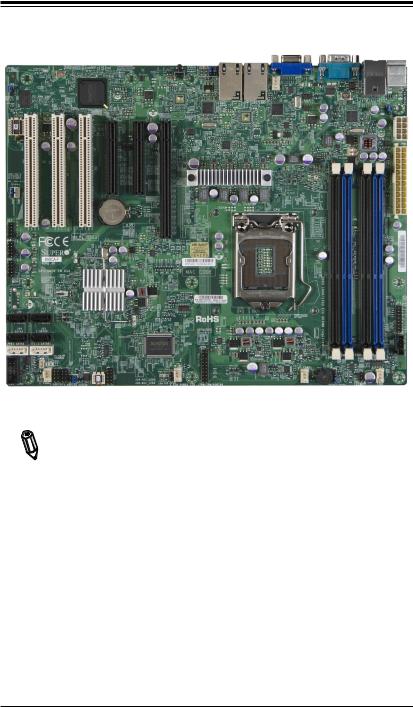






 X9SCi-LN4/X9SCi-LN4F/X9SCA/X9SCA-F
X9SCi-LN4/X9SCi-LN4F/X9SCA/X9SCA-F






 X9SCA Series Motherboard Image
X9SCA Series Motherboard Image
Note: All graphics shown in this manual were based upon the latest PCB Revision available at the time of publishing of the manual. The motherboard you've received may or may not look exactly the same as the graphics shown in this manual.
1-2
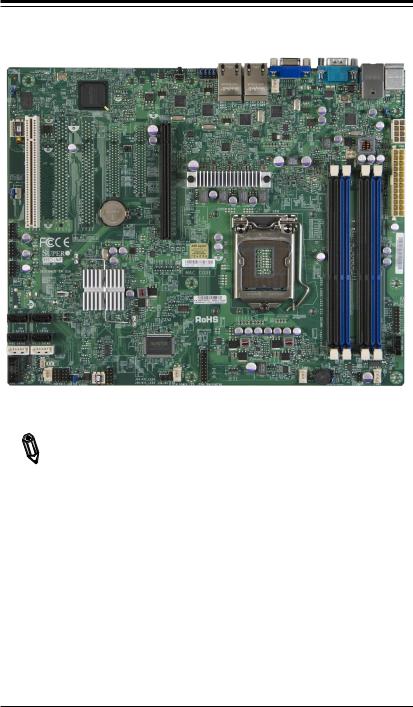
Chapter 1: Introduction





 X9SCi-LN4 Series Motherboard Image
X9SCi-LN4 Series Motherboard Image
Note: All graphics shown in this manual were based upon the latest PCB Revision available at the time of publishing of the manual. The motherboard you've received may or may not look exactly the same as the graphics shown in this manual.
1-3
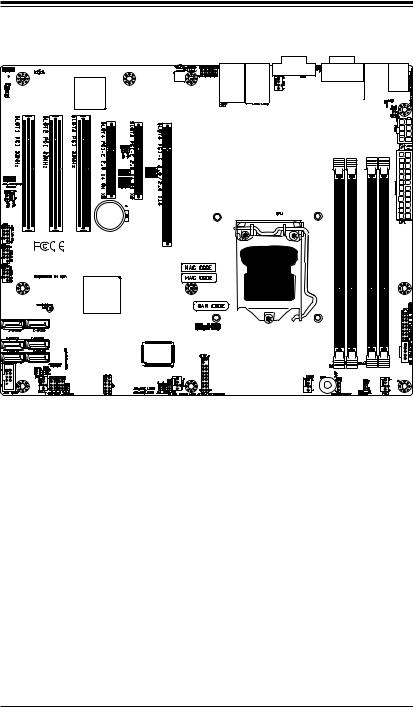






 X9SCi-LN4/X9SCi-LN4F/X9SCA/X9SCA-F
X9SCi-LN4/X9SCi-LN4F/X9SCA/X9SCA-F
Motherboard Layout (X9SCA Series)
Important Notes to the User
•See Chapter 2 for detailed information on jumpers, I/O ports and JF1 front panel connections.
•" " indicates the location of "Pin 1".
" indicates the location of "Pin 1".
•Jumpers not indicated are for testing only.
•When LE2 (Onboard Power LED Indicator) is on, system power is on. Unplug the power cable before installing or removing any components.
1-4
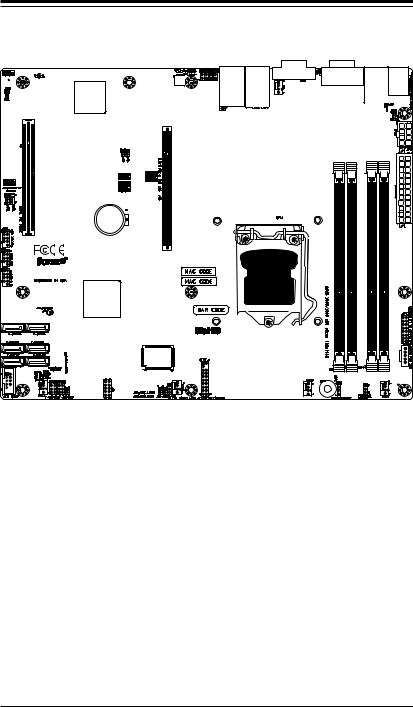
Chapter 1: Introduction
Motherboard Layout (X9SCi-LN4 Series)
Important Notes to the User
•See Chapter 2 for detailed information on jumpers, I/O ports and JF1 front panel connections.
•" " indicates the location of "Pin 1".
" indicates the location of "Pin 1".
•Jumpers not indicated are for testing only.
•When LE2 (Onboard Power LED Indicator) is on, system power is on. Unplug the power cable before installing or removing any components.
1-5
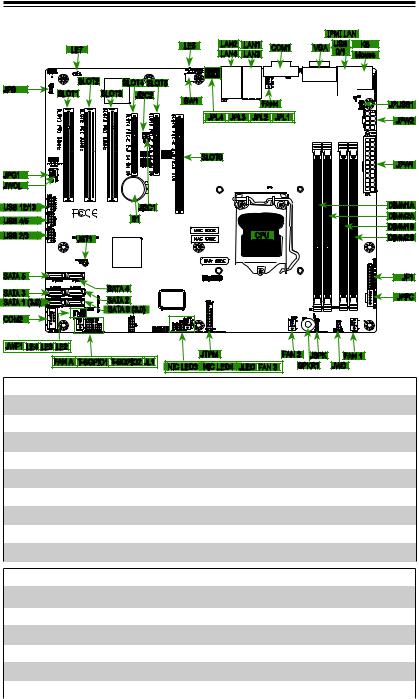






 X9SCi-LN4/X9SCi-LN4F/X9SCA/X9SCA-F
X9SCi-LN4/X9SCi-LN4F/X9SCA/X9SCA-F
X9SCi-LN4/X9SCi-LN4F/X9SCA/X9SCA-F Quick Reference
IPMI
 LAN
LAN
LE7 |
LE5 |
LAN2 |
LAN1 |
COM1 |
VGA |
USB |
KB |
|
LAN4 |
LAN3 |
|
|
0/1 |
Mouse |
JPB |
SLOT2 |
|
SLOT4 SLOT5 |
|
|
|
|
|
SLOT1 |
SLOT3 |
JI2C2 |
|
|
|
|
|
|
|
SW1 |
|
FAN4 |
JPUSB1 |
||||
|
|
|
|
|
||||
|
|
|
|
|
|
|||
|
|
|
|
JPL4 |
JPL3 |
JPL2 |
JPL1 |
JPW2 |
|
|
|
|
|
|
|
|
|
|
|
|
|
SLOT6 |
|
|
|
JPW1 |
|
|
|
|
|
|
|
|
|
JPG1 |
JWOL |
USB 12/13 |
|
JI2C1 |
|
|
|
|
|
DIMM1A |
|
USB 4/5 |
|
B1 |
|
|
|
|
|
DIMM2A |
|
|
|
|
|
|
|
DIMM1B |
|||
USB 2/3 |
|
|
|
|
CPU |
|
|
||
JBT1 |
|
|
|
|
|
DIMM2B |
|||
SATA 5 |
|
|
|
|
|
|
|
JF1 |
|
SATA 3 |
SATA 4 |
|
|
|
|
|
JPI2C |
||
SATA 2 |
|
|
|
|
|
||||
SATA 1 (3.0) |
|
|
|
|
|
|
|||
COM2 |
|
SATA 0 (3.0) |
|
|
|
|
|
|
|
|
|
|
|
|
|
|
|
||
JWF1 LE4 LE3 LE2 |
|
|
|
JTPM |
|
FAN 2 |
JSPK |
FAN 1 |
|
FAN A |
T-SGPIO1 |
T-SGPIO2 JL1 |
|
|
|||||
NIC LED3 |
NIC LED4 |
JLED FAN 3 |
SPKR1 |
JWD |
|||||
|
|
|
|||||||
X9SCi-LN4/X9SCi-LN4F/X9SCA/X9SCA-F Jumpers
Jumper |
Description |
Default |
|
|
|
JBT1 |
CMOS Clear |
(See Chpt. 2) |
|
|
|
JI2C1/JI2C2 |
SMB to PCI Slots |
(See Chpt. 2) |
JPB |
BMC Enable (X9SCi-LN4F, X9SCA-F Only) |
Pins 1-2 (Enabled) |
|
|
|
JPG1 |
Onboard VGA Enable |
Pins 1-2 (Enabled) |
|
|
|
JPL1/JPL2 |
LAN1/LAN2 Enable |
Pins 1-2 (Enabled) |
|
|
|
JPL3/JPL4 |
LAN3/LAN4 Enable (X9SCi-LN4/-LN4F only) |
Pins 1-2 (Enabled) |
|
|
|
JPUSB1 |
Backpanel USB 0/1 Wake-Up Enable |
Pins 1-2 (Enabled) |
|
|
|
JWD |
Watch Dog Timer Enable |
Pins 1-2 (Reset) |
|
|
|
X9SCi-LN4/X9SCi-LN4F/X9SCA/X9SCA-F LED Indicators
LED |
Description |
Color/State |
Status |
|
|
|
|
LE2 |
Onboard Power On LED |
Green: Solid on |
System On |
|
|
|
|
LE3 |
Unsupported Memory Installed Indicator |
Yellow: Blinking |
Unsupported Memory |
|
|
|
|
LE4 |
Onboard Standby PWR LED |
Green: Solid On |
Standy Power On |
|
|
|
|
LE5 |
UID (Unit ID) LED |
Blue: Solid On |
UID: On |
|
|
|
|
LE7 |
IPMI Heartbeat (X9SCi-LN4F, X9SCA-F Only) |
Green: Blinking |
IPMI Normal |
|
|
|
|
1-6

|
Chapter 1: Introduction |
|
|
|
|
|
|
X9SCi-LN4/X9SCi-LN4F/X9SCA/X9SCA-F Headers/Connectors |
|
Connector |
Description |
|
|
B1 |
Onboard Battery |
|
|
COM1, COM2 |
COM1 Backpanel Serial Port, COM2 Serial Port Header |
|
|
BIOS |
SPI BIOS |
|
|
Fans 1~4, Fan A |
System/CPU Fan Headers |
|
|
JF1 |
Front Panel Control Header |
|
|
JL1 |
Chassis Intrusion Header |
|
|
JLED1 |
Power LED Indicator Header |
JPW1 |
24-pin ATX Main Power Connector (Required) |
|
|
JPW2 |
+12V 8-pin CPU power Connector (Required) |
|
|
KB, Mouse |
Keyboard/Mouse Connectors |
|
|
LAN1/LAN2/LAN3/LAN4 |
Gigabit (RJ45) Ports (LAN3/LAN4 is supported on the X9SCi-LN4 only) |
|
|
IPMI LAN |
IPMI LAN (X9SCA-F/X8SCi-LN4F models only) |
|
|
SATA 0/1 |
Serial ATA 3.0 Ports 0/1 (6Mb/s) |
|
|
SATA 2~5 |
Serial ATA 2.0 Ports 2~5 (3Mb/s) |
|
|
JPI2C |
PWR supply (I2C) System Management Bus |
JSPK |
Speaker Header (Pins 3/4: Internal, 1~4:External) |
|
|
JTPM |
Trusted Platform Module (TPM) Header |
|
|
JWF1 |
SATA DOM (Disk On Module) Power Connector |
|
|
JWOL |
Wake On LAN Header |
|
|
SPKR1 |
Internal Speaker/Buzzer |
|
|
T-SGPIO-1/2 |
Serial Link General Purpose I/O 1/2 Headers (5V Gen1/Gen 2) |
|
|
USB0/1 |
Backpanel USB 0/1 |
|
|
USB2/3, USB4/5, |
Front Accessible USB Connections (via 3 Headers) |
USB 12/13 |
|
|
|
VGA |
Onboard Video Port |
|
|
NIC LED3, NIC LED4 |
LED Headers for LAN3 and LAN4 (X9SCi-LN4 Only) |
|
|
DIMM 1A, 2A, 1B, 2B |
1066/1333 DDR3 DIMM Slots (ECC, Unbuffered type is required) |
|
|
SW1 |
Unit ID Switch to turn on UID LED (LE5) |
|
|
Slot 1~3 |
33MHz PCI Slots (Slot 2/3 are not available on the X9SCi series) |
|
|
Slot 4~5 |
PCI-Express Slots x4 in x8 (Not available on the X9SCi series) |
|
|
Slot 6 |
PCI-Express Slot x16 |
|
|
1-7

X9SCi-LN4/X9SCi-LN4F/X9SCA/X9SCA-F |
||
|
|
|
Motherboard Features |
|
|
|
|
|
CPU |
Single Intel® Xeon E3-1200 series, 2nd generation Intel |
|
|
Core® i3, Pentium®, Celeron® processor in an LGA 1155 |
|
|
socket |
|
|
|
|
Memory |
Four (4) SDRAM slots support up to 32 GB of DDR3 Unbuf- |
|
|
fered, ECC 1333/1066 memory |
|
|
|
|
|
Supports dual-channel memory bus |
|
|
|
|
|
DIMM sizes |
|
|
UDIMM |
1 GB, 2 GB, 4GB, and 8GB |
|
|
|
Chipset |
Intel® C204 Standard |
|
Expansion Slots |
X9SCA/X9SCA-F Only |
|
|
|
Three (3) 33MHz PCI Slots |
||
|
|
|
|
|
|
|
Two (2) PCI-Express 2.0 x4 in x8 Slots |
||
|
|
|
|
|
|
|
One (1) PCI-Express 2.0 x16 Slot |
||
|
|
|
|
|
|
|
X9SCi-LN4/-LN4F Only |
|
|
|
|
One (1) 33MHz PCI Slot |
|
|
|
|
|
|
|
|
|
One (1) PCI-Express 2.0 x16 Slot |
||
|
|
|
|
|
Integrated Graphics |
Matrox® G200eW |
|
||
Network Connections |
Two (2) Intel 82574L (Four for the X9SCi-LN4/-LN4F) |
|||
|
|
Two (2) RJ-45 Rear IO Panel Connectors with Link and |
||
|
|
Activity LEDs, Four (4) for the X9SCi-LN4/-LN4F |
||
|
|
Single Realtek RTL8201N PHY to support IPMI 2.0 LAN |
||
|
|
(X9SCi-LN4F/X9SCA-F Only) |
||
I/O Devices |
SATA Connections |
|
||
|
|
SATA 3.0 Ports |
|
Two (2) (I-SATA 0/1) |
|
|
|
|
RAID 0, 1 Support |
|
|
|
|
|
|
|
SATA 2.0 Ports |
|
Four (4) (I-SATA 2~5) |
|
|
|
|
|
|
|
|
|
RAID 0, 1, 5, 10 |
|
|
|
|
|
|
|
Integrated IPMI 2.0 |
|
|
|
|
IPMI 2.0 supported by the WPCM450 Server BMC |
||
|
|
(X9SCi-LN4F/X9SCA-F Only) |
||
|
|
USB Devices |
|
|
|
|
Two (2) USB ports on the rear I/O panel (USB 0/1) |
||
|
|
|
|
|
|
|
Six (6) USB header connectors for front access (USB 2/3, |
||
|
|
USB 4/5, USB 12/13) |
|
|
1-8

Chapter 1: Introduction
|
Keyboard/Mouse |
|
PS/2 Keyboard/Mouse ports on the I/O backpanel |
|
Serial (COM) Ports |
|
Two (2) Fast UART 16550 connections: one 9-pin RS-232 |
|
port (Backplane COM1 port) and one header (FP COM2) |
|
Super I/O |
|
Winbond Super I/O NCT6776F |
|
|
BIOS |
64 Mb SPI AMI BIOS® SM Flash BIOS |
|
Plug and Play (PnP), DMI 2.3, PCI 2.3, ACPI 1.0/2.0/3.0, |
|
USB Keyboard and SMBIOS 2.5 |
Power Configuration |
ACPI/ACPM Power Management |
|
Main Switch Override Mechanism |
|
|
|
Keyboard Wake-up from Soft-Off |
|
|
|
Internal/External Modem Ring-On |
|
Power-on mode for AC power recovery |
|
|
PC Health Monitoring |
CPU Monitoring |
|
Onboard voltage monitors for CPU core, +3.3V, +5V, +/- |
|
12V, +3.3V Stdby, VBAT, Memory, VCORE for CPU |
|
CPU 4-phase switching voltage regulator |
|
|
|
CPU/System overheat LED and control |
|
CPU Thermal Trip support |
|
|
|
Thermal Monitor 2 (TM2) support |
|
Fan Control |
|
Fan status monitoring with firmware 4-pin (Pulse Width |
|
Modulation) fan speed control |
|
Low noise fan speed control |
|
|
System Management |
PECI (Platform Environment Configuration Interface) 2.0 |
|
support |
|
System resource alert via SuperDoctor® III |
|
|
|
SuperDoctor® III, Watch Dog, NMI |
|
Chassis Intrusion header and detection |
|
|
CD Utilities |
BIOS flash upgrade utility |
|
Drivers and software for Intel® C204 chipset utilities |
|
|
Other |
ROHS 6/6 (Full Compliance, Lead Free) |
Dimensions |
ATX form factor (12" x 9.6") |
Note: For IPMI Configuration Instructions, please refer to the Embedded
 IPMI Configuration User's Guide available at http://www.supermicro.com/ support/manuals/.
IPMI Configuration User's Guide available at http://www.supermicro.com/ support/manuals/.
1-9







 X9SCi-LN4/X9SCi-LN4F/X9SCA/X9SCA-F
X9SCi-LN4/X9SCi-LN4F/X9SCA/X9SCA-F
X9SCi-LN4/X9SCi-LN4F/X9SCA/X9SCA-F Block Diagram
BLOCK DIAGRAM |
RoHS 6/6 |
|
(SLOT6)
|
|
|
|
|
|
|
|
|
|
|
|
|
PCIe2.0_x16 |
|||
|
|
|
|
PCIe x16 SLOT |
|
|
||||||||||
|
|
|
|
|
|
|
5.0Gb |
|||||||||
|
|
|
|
|
|
(SLOT5) |
|
|
|
|||||||
|
|
|
|
|
|
|
|
PCIe2.0_x4 |
||||||||
PCIe x8 SLOT (X9SCA/-F only) |
|
|||||||||||||||
|
|
5.0Gb |
||||||||||||||
|
|
|
|
|
|
|
|
|
|
|
|
|
|
|||
|
|
|
|
|
|
|
|
SVID |
|
|
|
|||||
|
|
|
|
|
|
|
|
|
|
|
|
|
|
|||
|
|
|
|
|
|
|
|
|
|
|
|
|
|
|
|
|
|
|
|
VRM 12 |
|
|
|
|
|
|
|
|
|||||
|
|
|
MISC VRs |
|
|
|
|
|
|
|
|
|||||
|
P28-29 |
|
|
|
|
|
|
|
|
|||||||
|
|
|
|
|
|
|
|
|
|
|
PCIe_x4 |
5.0Gbps |
||||
PCIe x8 SLOT |
|
|||||||||||||||
|
(X9SCA/-F only) |
|
|
|
|
|
|
|||||||||
|
|
|
|
|
|
|
|
|
|
|
|
|
PCI32 |
|||
|
PCI 32 SLOT |
|
|
|||||||||||||
|
|
|
|
|
|
|
||||||||||
|
|
|
|
PCI32 |
|
|||||||||||
|
|
|
|
|
||||||||||||
|
PCI 32 SLOT |
|
|
|
||||||||||||
|
(X9SCA/-F only) |
|
|
|
|
|
|
|||||||||
|
|
|
|
PCI32 |
|
|||||||||||
|
PCI 32 SLOT |
|
|
|
||||||||||||
|
(X9SCA/-F only) |
|
|
|
|
|
|
|||||||||
|
|
|
|
|
|
|
|
|
|
|
|
SATA-II |
300MB/s |
|||
|
4 SATA PORTS |
|
|
|
|
|
|
|||||||||
|
|
|
|
|
|
|
|
|
|
|
|
SATA-III |
600MB/s |
|||
|
|
|
|
|
|
|
|
|
|
|
|
|||||
2 SATA PORTS |
|
|
|
|
|
|
||||||||||
|
|
|
|
|
|
|
|
|
|
|
USB2.0 |
480Mbps |
||||
|
|
|
|
|
|
|
|
|
|
|
||||||
|
8 USB PORTS |
|
|
|
|
|
|
|||||||||
|
|
|
|
|
|
|
|
|
|
|
|
|
|
LPC |
||
|
|
|
|
|
|
|
|
|
|
|
|
|
|
|||
TPM1.2 Header |
|
|
|
|||||||||||||
|
|
|
|
|
|
|||||||||||
|
|
|
|
|
|
|
|
|
|
|
|
SPI |
|
|||
|
|
|
|
|
|
|
|
|
|
|
|
|
|
|||
|
|
|
|
|
|
FLASH |
|
|
|
|
||||||
|
|
|
|
|
|
SPI 32Mb |
|
|
|
|
|
|
|
|||
|
|
|
|
|
|
|
|
|
|
|
|
|
|
|
|
|
|
|
|
|
|
|
|
|
|
|
|
|
|
|
|
COM1,2 |
|
|
|
|
|
|
|
|
|
|
|
|
|
|
|
|
|
|
|
|
|
|
|
|
|
|
|
|
|
|
|
|
|
|
P/S2 |
|
|
|
|
|
|
|
|
|
|
|
|
|
|
|
|
|
|
|
|
|
|
|
|
|
|
|
|
|
|
|
|
|
HEALTH |
|
|
|
|
|
|
|
|
|
|
|
|
|
|
|
|
INFO |
|
|
|
|
|
DDR3 (CHA) |
P9-10 |
|||||||||
|
|
|
|
|
|
DIMM1 |
|
||||||||
|
|
|
|
|
1333/1066MHz |
|
DIMM2(Far) |
4 UDIMM |
|||||||
|
Sandy Bridge |
|
|
|
|
|
P11-12 |
||||||||
|
|
|
DDR3 (CHB) |
|
|||||||||||
|
|
|
|
|
|
DIMM1 |
|
||||||||
|
|
|
|
|
1333/1066MHz |
|
DIMM2(Far) |
|
|||||||
|
|
|
|
|
|
|
|
|
|
|
|
|
|||
|
|
|
|
|
|
|
|
|
|
|
|
|
|
|
|
|
|
x4 DMI II 5.0Gb |
|
|
|
|
|
|
|
|
|
|
|
|
|
|
|
|
|
|
PCIe_x1 |
|
|
|
|
|
|
|
|
|
|
|
P13-16 |
|
|
GLAN1 |
|
|
|
|
RJ45 |
||||||
|
|
|
|
|
2.5Gbps |
82574L |
|
|
|
|
|||||
|
|
|
|
|
|
|
|
|
|
|
|
|
|||
|
|
|
|
|
PCIe_x1 |
|
|
|
|
|
|
|
|
|
|
|
|
|
|
|
GLAN2 |
|
|
|
|
RJ45 |
|||||
|
|
|
|
|
2.5Gbps |
82574 |
|
|
|
|
|
||||
|
Cougar Point |
|
|
|
|
|
|
|
|
|
|
|
|||
|
|
|
PCIe_x1 |
|
|
|
|
|
|
|
|
|
|
||
|
(C204 / C206) |
|
|
GLAN3 |
|
|
|
|
RJ45 |
||||||
|
|
PCH |
|
|
2.5Gbps |
82574L |
|
|
|
|
(X9SCI-LN4 only) |
||||
|
|
|
|
|
|
|
|
|
|
|
|||||
|
|
|
|
PCIe_x1 |
|
|
|
|
|
|
|
|
|
|
|
|
|
|
|
|
GLAN4 |
|
|
|
|
RJ45 |
|||||
|
|
|
|
|
2.5Gbps |
82574L |
|
|
|
|
(X9SCI-LN4 only) |
||||
|
|
|
|
|
|
|
|
|
|
|
|
||||
|
|
|
|
|
PCI32 |
|
|
|
|
|
|
|
|
|
|
|
|
|
|
|
|
|
|
|
|
|
|
|
|
|
|
|
|
|
|
|
HERMON WPCM450 |
|
|
|
|||||||
|
|
|
|
|
LPC |
|
|||||||||
|
|
|
|
|
WINBOND |
|
|
|
|||||||
|
|
|
|
|
|
|
|||||||||
|
|
|
|
|
|
|
|
|
|
|
|
|
|
|
|
|
|
|
|
|
|
RMII |
|
|
|
|
|
|
|
|
|
|
|
|
|
|
|
|
|
|
|
|
|
|
|
||
|
|
|
|
|
|
RTL8201 |
|
|
|
|
VGA |
|
|||
|
|
|
|
|
|
||||||||||
|
|
LPC |
|
|
|
PHY |
|
|
|
|
PORT |
|
|||
|
|
|
|
|
|
|
|
|
|
|
|
|
|
|
|
|
|
|
|
|
|
|
|
|
|
|
|
|
|
|
|
|
|
|
|
|
|
RJ45 |
|
|
|
|
|
|
|
|
|
|
|
|
|
|
|
(X9SCA-F only) |
|
||||||||
|
|
NCT6776F |
|
|
|
|
|
|
|
|
|
|
|
|
|
|
|
LPC I/O |
|
|
|
|
|
|
|
|
|
|
|
|
|
|
|
|
|
|
|
|
|
|
|
|
|
|
|
|
|
System Block Diagram
Note: This is a general block diagram and may not exactly represent the features on your motherboard. See the Motherboard Features pages for the actual specifications of each motherboard.
1-10

Chapter 1: Introduction
1-2 Chipset Overview
The X9SCi-LN4/X9SCA series motherboard supports a single Intel® Xeon E3-
1200 series, 2nd generation Intel Core® i3, Pentium®, Celeron® processor in an LGA 1155 socket. Built upon the functionality and the capability of the C204 chipset, the motherboard provides substantial enhancement to system performance and storage capability for Bromolow server platforms in a sleek package.
The high-speed Direct Media Interface (DMI) featured in the Intel C204 chipset supports high-speed Direct Media Interface (DMI) for chip-to-chip true isochronous communication, providing up to 10 Gb/s of software-transparent data transfer rate on each read/write direction. In addition, the X9SCi-LN4/X9SCA series motherboard also features the TCO timer which allows the system to recover from a software/hardware lock and perform tasks, including ECC Error Reporting, Function Disable and Intruder Detect.
Intel C204 Chipset Features
•Direct Media Interface (up 10 Gb/s transfer, Full Duplex)
•Intel® Matrix Storage Technology and Intel Rapid Storage Technology
•Intel I/O Virtualization (VT-d) Support
•Intel Trusted Execution Technology Support
•PCI Express 2.0 Interface (up to 5.0 GT/s)
•SATA Controller (up to 3G/s)
•Advanced Host Controller Interface (AHCI)
•Two (2) SATA 3.0 ports (up to 6G/s)
1-11



 X9SCi-LN4/X9SCi-LN4F/X9SCA/X9SCA-F
X9SCi-LN4/X9SCi-LN4F/X9SCA/X9SCA-F
1-3 Special Features
Recovery from AC Power Loss
Basic I/O System (BIOS) provides a setting for you to determine how the system will respond when AC power is lost and then restored to the system. You can choose for the system to remain powered off (in which case you must press the power switch to turn it back on), or for it to automatically return to a power-on state. See the Advanced BIOS Setup section to change this setting. The default setting is Last State.
1-4 PC Health Monitoring
This section describes the PC health monitoring features of the board. All have an onboard System Hardware Monitoring chip that supports PC health monitoring. An onboard voltage monitor will scan these onboard voltages continuously: CPU Vcore, NIC Vcore, BMC Vcore, AUX Vcore, Standby ME Vcore, 12V Scale, 1.5V, 3.3V Vcc(V), 3.3VSB, and Battery Voltage. Once a voltage becomes unstable, a warning is given, or an error message is sent to the screen. The user can adjust the voltage thresholds to define the sensitivity of the voltage monitor.
Fan Status Monitor with Firmware Control
PC health monitoring in the BIOS can check the RPM status of the cooling fans. The onboard CPU and chassis fans are controlled by Thermal Management via BIOS (under the Hardware Monitoring section in the Advanced Setting).
Environmental Temperature Control
The thermal control sensor monitors the CPU temperature in real time and will turn on the thermal control fan whenever the CPU temperature exceeds a user-defined threshold. The overheat circuitry runs independently from the CPU. Once the thermal sensor detects that the CPU temperature is too high, it will automatically turn on the thermal fans to prevent the CPU from overheating. The onboard chassis thermal circuitry can monitor the overall system temperature and alert the user when the chassis temperature is too high.
Note: To avoid possible system overheating, please be sure to provide adequate airflow to your system.
System Resource Alert
This feature is available when the system is used with SuperDoctor® III in the
1-12

Chapter 1: Introduction
Windows OS environment or used with SuperDoctor II in Linux. SuperDoctor is used to notify the user of certain system events. For example, you can also configure SuperDoctor to provide you with warnings when the system temperature, CPU temperatures, voltages and fan speeds go beyond predefined thresholds.
1-5 ACPI Features
ACPI stands for Advanced Configuration and Power Interface. The ACPI specification defines a flexible and abstract hardware interface that provides a standard way to integrate power management features throughout a PC system, including its hardware, operating system and application software. This enables the system to automatically turn on and off peripherals such as CD-ROMs, network cards, hard disk drives and printers.
In addition to enabling operating system-directed power management, ACPI also provides a generic system event mechanism for Plug and Play, and an operating system-independent interface for configuration control.ACPI leverages the Plug and
Play BIOS data structures, while providing a processor architecture-independent implementation that is compatible with Windows XP, Windows Vista and Windows 2008 Operating Systems.
Slow Blinking LED for Suspend-State Indicator
When the CPU goes into a suspend state, the chassis power LED will start to blink to indicate that the CPU is in suspend mode. When the user presses any key, the CPU will "wake up", and the LED will automatically stop blinking and remain on.
1-6 Power Supply
As with all computer products, a stable power source is necessary for proper and reliable operation. It is even more important for processors that have high CPU clock rates.
This motherboard accommodates 24-pin ATX power supplies. Although most power supplies generally meet the specifications required by the CPU, some are inadequate. In addition, the 12V 8-pin power connector located at JPW2 is also required to ensure adequate power supply to the system. Also your power supply must supply 1.5A for the Ethernet ports.
Warning: 1. To prevent damage to the power supply or motherboard, please use a power supply that contains a 24-pin and a 8-pin power connectors. Be sure to connect these connectors to the 24-pin (JPW1) and the 8-pin (JPW2) power connectors on the motherboard. Failure in doing so will void the manufacturer warranty on your power supply and motherboard.
1-13







 X9SCi-LN4/X9SCi-LN4F/X9SCA/X9SCA-F
X9SCi-LN4/X9SCi-LN4F/X9SCA/X9SCA-F
2. To provide adequate power to SATA devices, please connect the SATA DOM PWR connector (JWF1) to the power supply.
It is strongly recommended that you use a high quality power supply that meets ATX power supply Specification 2.02 or above. It must also be SSI compliant. (For more information, please refer to the web site at http://www.ssiforum.org/). Additionally, in areas where noisy power transmission is present, you may choose to install a line filter to shield the computer from noise. It is recommended that you also install a power surge protector to help avoid problems caused by power surges.
1-7 Super I/O
The Super I/O supports two high-speed, 16550 compatible serial communication ports (UARTs). Each UART includes a 16-byte send/receive FIFO, a programmable baud rate generator, complete modem control capability and a processor interrupt system. Both UARTs provide legacy speed with baud rate of up to 115.2 Kbps as well as an advanced speed with baud rates of 250 K, 500 K, or 1 Mb/s, which support higher speed modems.
The Super I/O provides functions that comply with ACPI (Advanced Configuration and Power Interface), which includes support of legacy and ACPI power management through an SMI or SCI function pin. It also features auto power management to reduce power consumption.
1-8 Overview of the Nuvoton WPCM450 Controller
The Nuvoton WPCM450R Controller is a Baseboard Management Controller (BMC) that supports 2D/VGA-compatible Graphics cores, Virtual Media, and Keyboard/ Video/Mouse Redirection (KVMR) modules. With blade-oriented Super I/O capability built in, the WPCM450R Controller is ideal for legacy-reduced server platforms.
The WPCM450R interfaces with a host system via PCI interface to communicate with the Graphics core. It supports USB 2.0 and 1.1 for remote keyboard/mouse/ virtual media emulation. It also provides LPC interface to control Super IO functions. The WPCM450R is connected to the network via an external Ethernet PHY module.
The WPCM450R communicates with onboard components via six SMBus interfaces, fan control, and Platform Environment Control Interface (PECI) buses.
Note: For more information on IPMI configuration, please refer to the Embedded IPMI User's Guide posted on our website at http://www.supermicro. com/support/manuals/.
1-14

Chapter 2: Installation
Chapter 2
Installation
2-1 Static-Sensitive Devices
Electrostatic-Discharge (ESD) can damage electronic components. To avoid damaging your system board, it is important to handle it very carefully. The following measures are generally sufficient to protect your equipment from ESD.
Precautions
•Use a grounded wrist strap designed to prevent static discharge.
•Touch a grounded metal object before removing the board from the antistatic bag.
•Handle the board by its edges only; do not touch its components, peripheral chips, memory modules or gold contacts.
•When handling chips or modules, avoid touching their pins.
•Put the motherboard and peripherals back into their antistatic bags when not in use.
•For grounding purposes, make sure your computer chassis provides excellent conductivity between the power supply, the case, the mounting fasteners and the motherboard.
•Use only the correct type of onboard CMOS battery. Do not install the onboard battery upside down to avoid possible explosion.
Unpacking
The motherboard is shipped in antistatic packaging to avoid static damage. When unpacking the board, make sure that the person handling it is static protected.
2-1
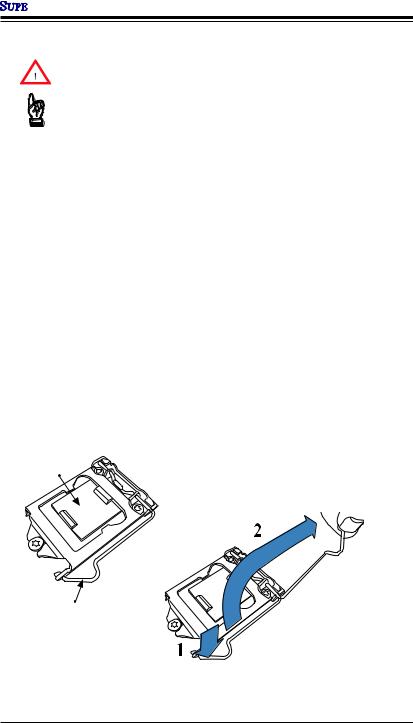


 X9SCi-LN4/X9SCi-LN4F/X9SCA/X9SCA-F
X9SCi-LN4/X9SCi-LN4F/X9SCA/X9SCA-F
2-2 Processor and Heatsink Installation
Warning: When handling the processor package, avoid placing direct pressure on the label area of the fan.
Important:
•Always connect the power cord last, and always remove it before adding, removing or changing any hardware components. Make sure that you install the processor into the CPU socket before you install the CPU heatsink.
•If you buy a CPU separately, make sure that you use an Intel-certified multidirectional heatsink only.
•Make sure to install the system board into the chassis before you install the CPU heatsink.
•When receiving a server board without a processor pre-installed, make sure that the plastic CPU socket cap is in place and none of the socket pins are bent; otherwise, contact your retailer immediately.
•Refer to the Supermicro website for updates on CPU support.
Installing the LGA1155 Processor
1.Press the load lever to release the load plate, which covers the CPU socket, from its locking position.
Load Plate
Load Lever
2-2
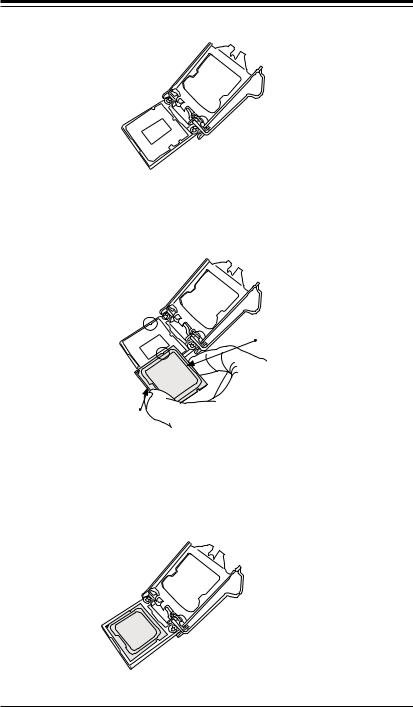
Chapter 2: Installation
2. Gently lift the load lever to open the load plate. Remove the plastic cap.
3.Use your thumb and your index finger to hold the CPU at the North center edge and the South center edge of the CPU.
North Center Edge
South Center Edge
4.Align the CPU key that is the semi-circle cutouts against the socket keys. Once it is aligned, carefully lower the CPU straight down into the socket. (Do not drop the CPU on the socket. Do not move the CPU horizontally or vertically.
2-3
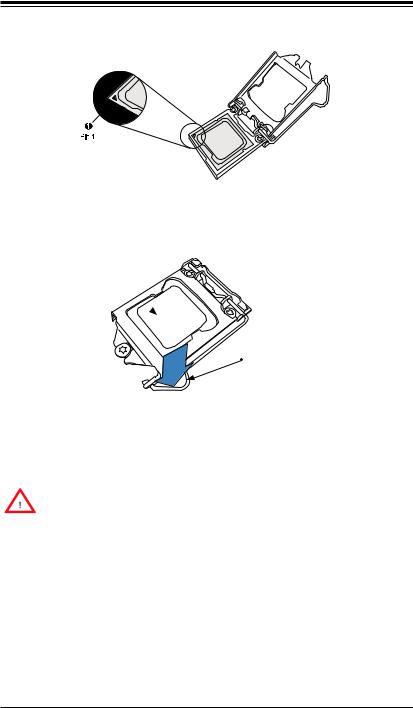






 X9SCi-LN4/X9SCi-LN4F/X9SCA/X9SCA-F
X9SCi-LN4/X9SCi-LN4F/X9SCA/X9SCA-F
5. Do not rub the CPU against the surface or against any pins of the socket to avoid damaging the CPU or the socket.)
6.With the CPU inside the socket, inspect the four corners of the CPU to make sure that the CPU is properly installed.
7.Use your thumb to gently push the load lever down to the lever lock.
CPU properly installed 
Load lever locked
into place
Warning: You can only install the CPU inside the socket only in one direction. Make sure that it is properly inserted into the CPU socket before closing the load plate. If it doesn't close properly, do not force it as it may damage your CPU. Instead, open the load plate again and double-check that the CPU is aligned properly.
2-4
